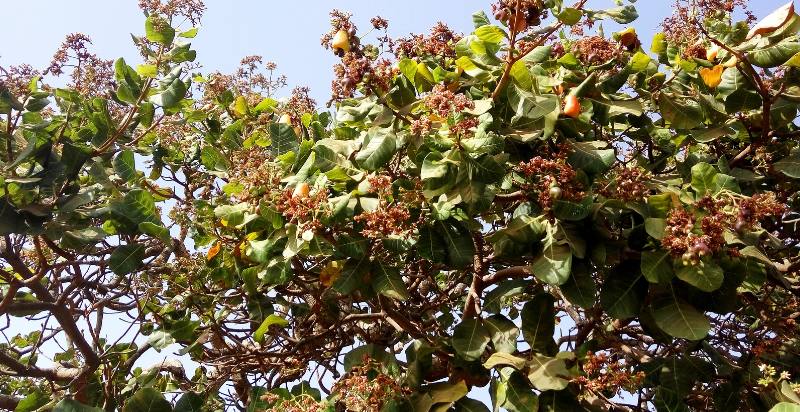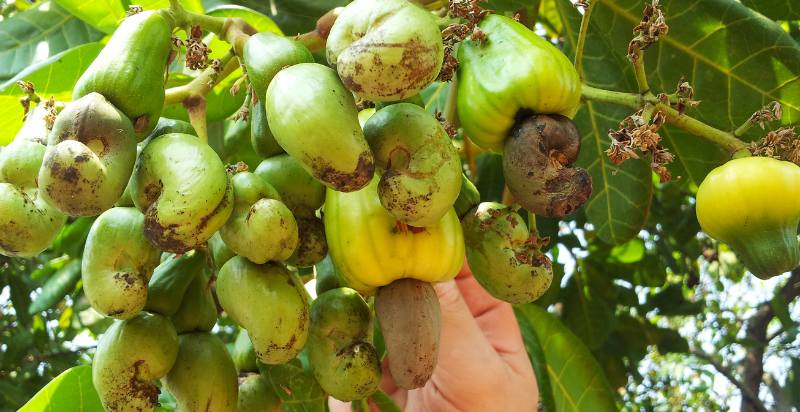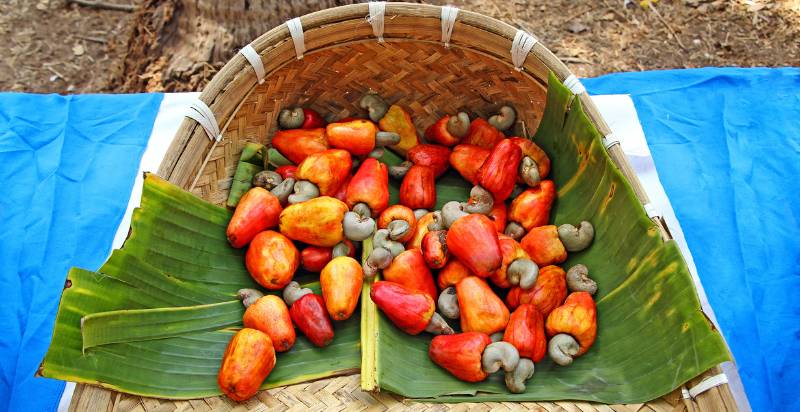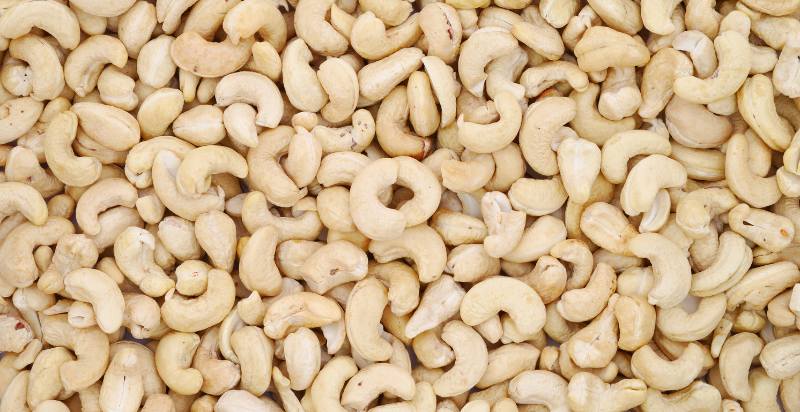An evergreen tropical tree that produces cashew nuts is the cashew tree (Anacardium occidentale). While they can reach heights of up to 14 m (46 ft), dwarf cashews, which only reach heights of up to 6 m (20 ft), be more productive due to their earlier maturity and higher yields. The cashew nut often called simply cashew, is widely consumed. It can be consumed independently, added to dishes, or made into cashew cheese or butter.
History of Cashews:
The Portuguese took the cashew tree from its native home in Brazil to India and Africa in the 16th century. They began the cultivation of the trees in these new lands, and soon the cashew became an important commercial crop. Today, cashew is grown in tropical regions worldwide, including Brazil, India, Vietnam, Africa, and Indonesia.
Cashews are a popular ingredient in many cuisines. They are used in sweet dishes, such as desserts, sweetened beverages, and savory dishes. They are often ground into a paste and used as a base for curries in India. These are used in a popular sweet and a sour soup called Canh Chua in Vietnam. And in Africa, they are roasted and eaten as a snack.
The cashew nut is rich in vitamins and minerals, including magnesium, phosphorus, zinc, copper, manganese, iron, selenium, and vitamin K. It is a wonderful source of fiber, protein, and beneficial fats.
Cashews are a fantastic choice for persons watching their weight because they contain fewer calories than other nuts. One ounce (28 grams) of cashews provides 157 calories, 2.5 grams of carbohydrates, 9 grams of fat, and 5 grams protein.
Description of Cashews:
The cashew tree is a tropical evergreen that can reach heights of up to 14 meters (46 feet), but dwarf cashews, which can reach heights of up to 6 meters (20 feet), have proven to be more productive due to their earlier maturity and higher yields. It’s common to eat cashew nuts, often known as cashews. It can be consumed independently, added to dishes, or made into cashew cheese or butter.
The fruit known as the cashew apple develops at the end of the cashew nut. Although apples are frequently consumed raw, they can also be used to create jams, jellies, and wines.
Northeastern Brazil is the origin of cashews. Vietnam, Nigeria, India, and the Ivory Coast are the countries that produce the most cashews.
The tree produces flowers that are small and white, with five petals. The fruit consists of an outer fleshy layer (the hypocarpium), which surrounds the actual seed (the cashew nut). The hypocarpium is pear-shaped and red or yellow when ripe.
The kidney-shaped cashew nut has a stalk that connects it to the hypocarpium. The nut is enclosed in a hard shell that is greenish-brown in color. The shell contains urushiol, a potent irritant that can cause skin rashes in some people.

Health Benefits of Cashews:
Cashews are packed with nutrients that can offer a variety of health benefits. Here are some of the most impressive health benefits of cashews:
Cashews are a good source of protein, fat, and minerals such as iron and phosphorus. They provide a good amount of antioxidants as well.
Antioxidants are chemicals that can shield cells from harm by free radical molecules. Free radicals are created when the body digests food or is exposed to radiation and cigarette smoke. Inflicting cell damage from free radicals can result in cancer, heart disease, and other disorders.
Cashews include antioxidants that may aid in preventing free radical damage to cells. Additionally, cashews are a wonderful source of magnesium essential for strong, healthy bones.
How to Grow and Care for Your Cashew Plant?
If you’re interested in growing your cashew tree, it’s important to know that they require a warm, humid climate and well-drained soil. Cashew trees are generally propagated from seed but can also be grafted or budded.
When planting cashew seeds, it’s best to start them in containers indoors 6-8 weeks before the last frost date in your area. Plant the seeds ½ inch (1 cm) deep in moist potting soil and keep them at a temperature of 70-85°F (21-29°C). The seeds will germinate within 2-4 weeks.
Once the seedlings have reached 6 inches (15 cm) tall, they can be transplanted outdoors. Choose a location in full sun with well-drained soil. Cashew trees can tolerate partial shade but will not produce as many nuts.
When transplanting, be careful not to damage the taproot. The taproot is the long, thick root that grows straight down from the seedling. It is very sensitive and easily damaged.
Water your cashew tree regularly, especially during dry periods. The tree will need 1-2 inches (2.5-5 cm) of water per week. Apply a layer of mulch around the tree’s base to help retain moisture in the soil.
Fertilize your cashew tree 2-3 times per year with a balanced fertilizer. Follow the directions on the package for proper application.

Prevention from Pests and Diseases:
Pests and diseases are common problems in cashew production. Common pests include cashew stem borers, which can damage the tree’s bark and cause the leaves to fall off. Other pests include the cashew weevil, which bores into the nuts, and the mealybug, which sucks the sap from the tree and produces a sticky substance that can attract ants.
Root rot, stem rot, and leaf spot diseases affect cashew trees. Stem rot damages the stems and leaves of the tree, whereas a fungus infects the tree’s roots to induce root rot.
A fungus infects the leaves, turning them yellow or brown until they eventually fall off. This is what is known as a leaf spot.
To prevent pests and diseases, keeping the cashew trees healthy and free of debris is important. Trees should be pruned regularly to remove dead branches, and the area around the tree should be kept clean.
In addition, cashew trees need to be fertilized regularly with a balanced fertilizer. This will help to ensure that the trees have all the nutrients they need to stay healthy and productive.
Harvesting Cashew Nuts:
Cashew nuts are typically ready to harvest 8-10 months after planting. The nuts will mature at different times, so you may need to harvest them over several weeks.
To harvest the nuts, twist them off of the tree. They should come off easily when they are ripe. Once harvested, the nuts can be eaten fresh or roasted. They can also be processed into cashew butter or cheese.
Cashew trees are relatively low maintenance and easy to care for. With proper care, they can produce nuts for many years.

How To Store-Grown Cashew?
For up to six months, cashew can be kept dry and cool in storage. It’s preferable to keep them in a cool basement or garage if you have the room.
As soon as they are ripe, the nuts should be taken off the tree to preserve them fresh. The nuts can be kept for up to two weeks in the refrigerator in an airtight container after being collected.
They can be frozen for up to six months if you want to keep them for longer lengths of time. As much air as possible should be drawn out of the freezer bag containing the nuts before it is sealed.
How To Eat Grown Cashews?
Cashews are often eaten as a snack or used as an ingredient in recipes. When sold commercially, they are often roasted before they are sold.
You can roast cashews at home if you have never done so. To achieve this, spread the cashews out on a baking sheet and bake them for about 10 minutes in an oven preheated to 350 degrees Fahrenheit. They can also be prepared for about 5 minutes over medium heat in a pan on the stove.
Once roasted, you can eat the cashews whole or use them in recipes. Cashews can be used in sweet or savory dishes. For example, they can be added to cookies, cakes, and other desserts. Or, they can be used in savory dishes such as curries or stir-fries.

Possible Side Effects
The cashew nut shell contains urushiol, a potent irritant that can cause skin rashes in some people. Because of this, the nuts are often roasted before they are sold. Roasting the nuts removes the urushiol and makes them safe to eat.
If you come into touch with the nuts or their byproducts while allergic to cashews, you can develop hives, edema, and breathing problems. A severe allergic reaction called anaphylaxis, which can be fatal may occur.
Cashews may cause an allergic response if you are allergic to tree nuts. Allergies to tree nuts are frequent and sometimes dangerous. Cashews and all items containing them should be avoided if you are allergic to tree nuts.
You should see a doctor immediately if you experience any symptoms after eating cashews or coming into contact with them.
Conclusion
Cashew trees are a great way to add variety to your home-grown nut collection. Their sweet, buttery flavor makes them a delicious addition to any recipe. And with so many health benefits, they’re a great choice for anyone looking to improve their overall health.
- Everything You Wanted to Know About Red Tamarillos - June 2, 2025
- A Guide to Tulips: Everything You Need to Know & More… - June 2, 2025
- Guanabana: Description, Flavor, Benefits, And Uses - May 27, 2025

1 thought on “Cashew Trees: How to Grow and Care for your Cashew Plant”
Comments are closed.